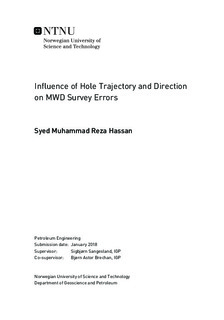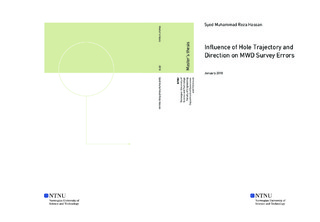| dc.description.abstract | Wellbore positioning is important to meet directional drilling objectives. Inaccurate wellbore surveys can lead to wellbore collision, failure to penetrate thin reservoir sections and drilling of relief wells etc. Such consequences make accurate wellbore positioning essential. Wellbore survey data needed to calculate wellbore position at any point is commonly obtained through MWD tools.
The measurement accuracy of frequently used MWD tools usually decreases with increasing hole inclination and depth. This introduces uncertainties in wellbore position estimates. The Industry Steering Committee for Wellbore Survey Accuracy (ISCWSA) has proposed several survey error models to estimate Wellbore Position Uncertainty (WPU) at any depth along the well. The parameters in model s sensitivity to direction and nature of trajectory has not been discussed before. Therefore, this thesis has analyzed the behavior of all major MWD survey error sources in vertical, build up and horizontal sections of the three wells drilled in North/South, North/East and East/West directions.
A software model has been developed to analyze the influence of various MWD survey error sources in different drilling directions. The model is based on mathematical equations presented in Non-mag and Mag-corr ISCWSA MWD error models. The error terms from both are modeled to study the impact of each error source on measurement and position uncertainties. Finally, a comparison of the two survey error models is presented.
As drilling progresses, various survey errors tend to push the well path away from the planned course. Some dominate the process while others hardly influence. For example, results in this thesis show that magnetic axial drill string interference is least effective in North/South well, but is the major uncertainty source in East/West well. Similarly, it has been observed that an error source can be least effective in the vertical section and dominate the total uncertainty budget in the deviated part, for example BHA sag. The third category of error sources has been observed to be completely independent of inclination or azimuth, for example declination error. This unique behavior of different error sources is totally governed by their respective weighting functions.
Results further show that the effect of an error source on measurement and position uncertainty is not necessarily the same. Large azimuth errors may not have an equally large impact on position uncertainty and vice versa. Also, the effectiveness of an error source is typically dependent upon its effect on total measurement or position error budget. An error source can cause large individual position uncertainty without having any significant influence on total position uncertainty budget.
This thesis can be further extended to include the effects of magnetic mud on wellbore position uncertainty. Specific error terms for this purpose should be formulated to model this effect. Also, a similar analysis can be made for Gyroscopic tools utilizing its own error terms. | |

